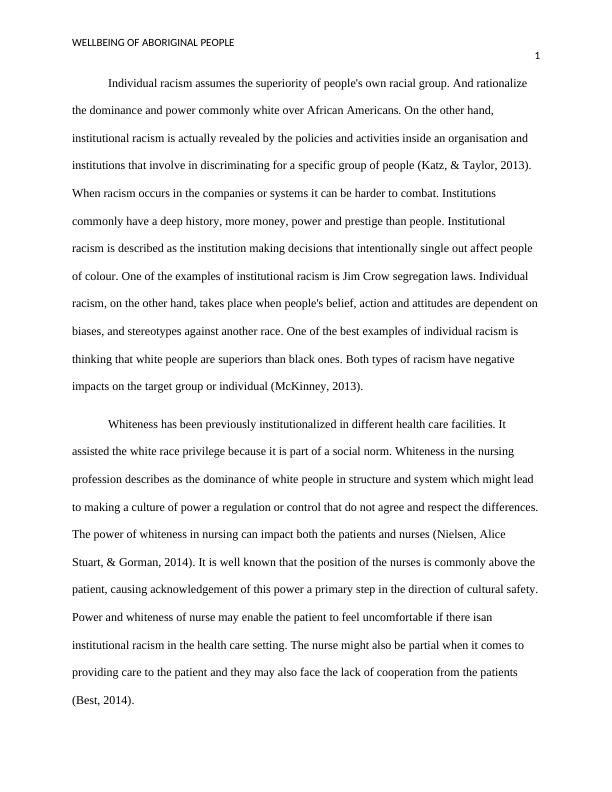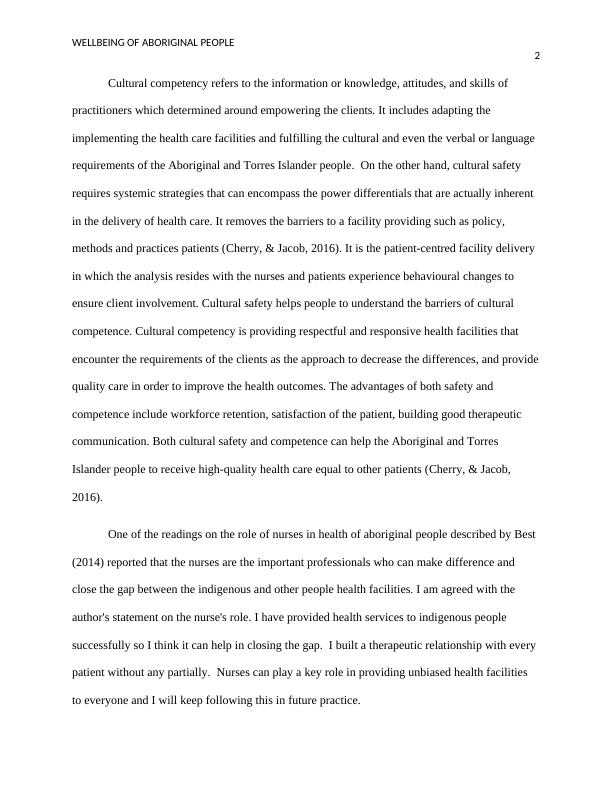Wellbeing of Aboriginal People
Added on 2023-04-20
9 Pages2601 Words497 Views
Running head: WELLBEING OF ABORIGINAL PEOPLE
0
Wellbeing of Aboriginal people
student
3/28/2019
0
Wellbeing of Aboriginal people
student
3/28/2019

WELLBEING OF ABORIGINAL PEOPLE
1
Individual racism assumes the superiority of people's own racial group. And rationalize
the dominance and power commonly white over African Americans. On the other hand,
institutional racism is actually revealed by the policies and activities inside an organisation and
institutions that involve in discriminating for a specific group of people (Katz, & Taylor, 2013).
When racism occurs in the companies or systems it can be harder to combat. Institutions
commonly have a deep history, more money, power and prestige than people. Institutional
racism is described as the institution making decisions that intentionally single out affect people
of colour. One of the examples of institutional racism is Jim Crow segregation laws. Individual
racism, on the other hand, takes place when people's belief, action and attitudes are dependent on
biases, and stereotypes against another race. One of the best examples of individual racism is
thinking that white people are superiors than black ones. Both types of racism have negative
impacts on the target group or individual (McKinney, 2013).
Whiteness has been previously institutionalized in different health care facilities. It
assisted the white race privilege because it is part of a social norm. Whiteness in the nursing
profession describes as the dominance of white people in structure and system which might lead
to making a culture of power a regulation or control that do not agree and respect the differences.
The power of whiteness in nursing can impact both the patients and nurses (Nielsen, Alice
Stuart, & Gorman, 2014). It is well known that the position of the nurses is commonly above the
patient, causing acknowledgement of this power a primary step in the direction of cultural safety.
Power and whiteness of nurse may enable the patient to feel uncomfortable if there isan
institutional racism in the health care setting. The nurse might also be partial when it comes to
providing care to the patient and they may also face the lack of cooperation from the patients
(Best, 2014).
1
Individual racism assumes the superiority of people's own racial group. And rationalize
the dominance and power commonly white over African Americans. On the other hand,
institutional racism is actually revealed by the policies and activities inside an organisation and
institutions that involve in discriminating for a specific group of people (Katz, & Taylor, 2013).
When racism occurs in the companies or systems it can be harder to combat. Institutions
commonly have a deep history, more money, power and prestige than people. Institutional
racism is described as the institution making decisions that intentionally single out affect people
of colour. One of the examples of institutional racism is Jim Crow segregation laws. Individual
racism, on the other hand, takes place when people's belief, action and attitudes are dependent on
biases, and stereotypes against another race. One of the best examples of individual racism is
thinking that white people are superiors than black ones. Both types of racism have negative
impacts on the target group or individual (McKinney, 2013).
Whiteness has been previously institutionalized in different health care facilities. It
assisted the white race privilege because it is part of a social norm. Whiteness in the nursing
profession describes as the dominance of white people in structure and system which might lead
to making a culture of power a regulation or control that do not agree and respect the differences.
The power of whiteness in nursing can impact both the patients and nurses (Nielsen, Alice
Stuart, & Gorman, 2014). It is well known that the position of the nurses is commonly above the
patient, causing acknowledgement of this power a primary step in the direction of cultural safety.
Power and whiteness of nurse may enable the patient to feel uncomfortable if there isan
institutional racism in the health care setting. The nurse might also be partial when it comes to
providing care to the patient and they may also face the lack of cooperation from the patients
(Best, 2014).

WELLBEING OF ABORIGINAL PEOPLE
2
Cultural competency refers to the information or knowledge, attitudes, and skills of
practitioners which determined around empowering the clients. It includes adapting the
implementing the health care facilities and fulfilling the cultural and even the verbal or language
requirements of the Aboriginal and Torres Islander people. On the other hand, cultural safety
requires systemic strategies that can encompass the power differentials that are actually inherent
in the delivery of health care. It removes the barriers to a facility providing such as policy,
methods and practices patients (Cherry, & Jacob, 2016). It is the patient-centred facility delivery
in which the analysis resides with the nurses and patients experience behavioural changes to
ensure client involvement. Cultural safety helps people to understand the barriers of cultural
competence. Cultural competency is providing respectful and responsive health facilities that
encounter the requirements of the clients as the approach to decrease the differences, and provide
quality care in order to improve the health outcomes. The advantages of both safety and
competence include workforce retention, satisfaction of the patient, building good therapeutic
communication. Both cultural safety and competence can help the Aboriginal and Torres
Islander people to receive high-quality health care equal to other patients (Cherry, & Jacob,
2016).
One of the readings on the role of nurses in health of aboriginal people described by Best
(2014) reported that the nurses are the important professionals who can make difference and
close the gap between the indigenous and other people health facilities. I am agreed with the
author's statement on the nurse's role. I have provided health services to indigenous people
successfully so I think it can help in closing the gap. I built a therapeutic relationship with every
patient without any partially. Nurses can play a key role in providing unbiased health facilities
to everyone and I will keep following this in future practice.
2
Cultural competency refers to the information or knowledge, attitudes, and skills of
practitioners which determined around empowering the clients. It includes adapting the
implementing the health care facilities and fulfilling the cultural and even the verbal or language
requirements of the Aboriginal and Torres Islander people. On the other hand, cultural safety
requires systemic strategies that can encompass the power differentials that are actually inherent
in the delivery of health care. It removes the barriers to a facility providing such as policy,
methods and practices patients (Cherry, & Jacob, 2016). It is the patient-centred facility delivery
in which the analysis resides with the nurses and patients experience behavioural changes to
ensure client involvement. Cultural safety helps people to understand the barriers of cultural
competence. Cultural competency is providing respectful and responsive health facilities that
encounter the requirements of the clients as the approach to decrease the differences, and provide
quality care in order to improve the health outcomes. The advantages of both safety and
competence include workforce retention, satisfaction of the patient, building good therapeutic
communication. Both cultural safety and competence can help the Aboriginal and Torres
Islander people to receive high-quality health care equal to other patients (Cherry, & Jacob,
2016).
One of the readings on the role of nurses in health of aboriginal people described by Best
(2014) reported that the nurses are the important professionals who can make difference and
close the gap between the indigenous and other people health facilities. I am agreed with the
author's statement on the nurse's role. I have provided health services to indigenous people
successfully so I think it can help in closing the gap. I built a therapeutic relationship with every
patient without any partially. Nurses can play a key role in providing unbiased health facilities
to everyone and I will keep following this in future practice.

End of preview
Want to access all the pages? Upload your documents or become a member.
Related Documents
Cultural Safetylg...
|11
|3180
|173
Comparison between personal racism and systematic racismlg...
|12
|3044
|202
Role of Nurses in Addressing Health Needs of Aboriginal and Torres Strait Islander Peoplelg...
|12
|2497
|65
Aboriginal & Torres Strait Islander Peoples’ Wellbeinglg...
|10
|2498
|206
Racism in Australia: Personal and Institutional Discriminationlg...
|13
|2674
|158
Aboriginal and Torres Strait Islanders’ Wellbeinglg...
|10
|2766
|395
